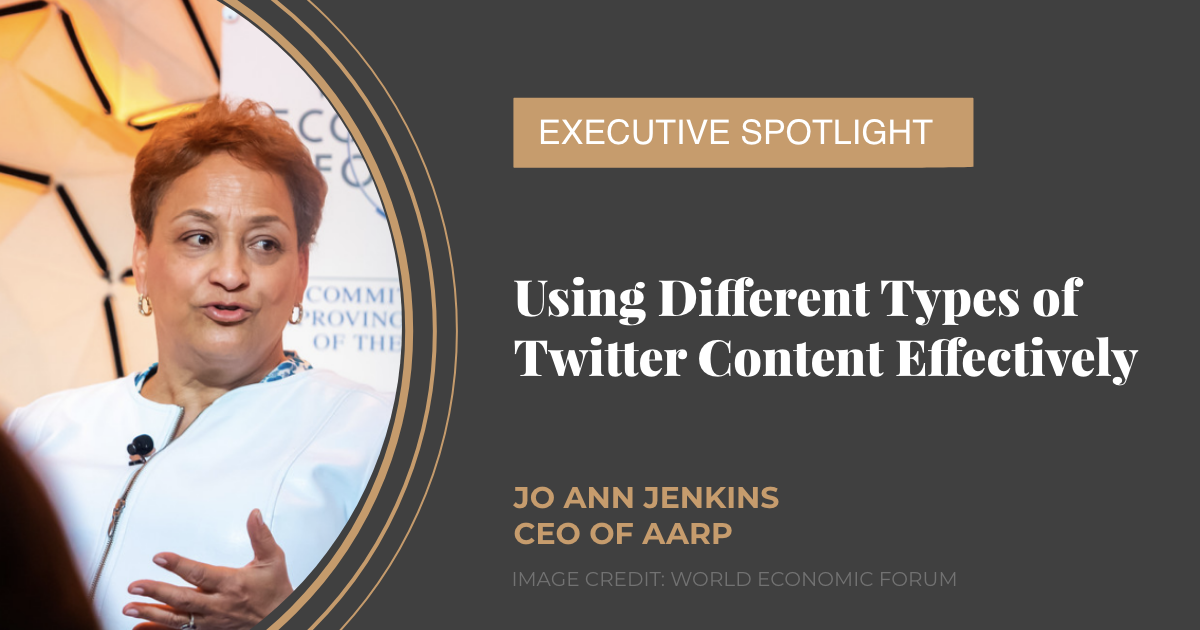From text-only posts, to videos, to third-party articles, executives have a variety of content types to choose from when posting on social media. In this article, we put the spotlight on Jo Ann Jenkins, the CEO of AARP. Based in the U.S., AARP is the largest nonprofit organization in the country and provides benefits for citizens over 50 years old. Using social media profiles on both LinkedIn and Twitter, Jenkins has developed a strong brand voice across her social media content.
LinkedIn: Potential to Grow Personal Branding
Starting with LinkedIn, Jenkin’s About section on her profile is effective, covering key points in her career. We always recommend that executives start off with their most recent position, which Jenkins has done. The About section is also a good way to optimize for relevant keywords related to the executive and their industry, which can lead to the individual showing up in more search results.
While Jenkins has posted several long-form articles on LinkedIn, most of her articles are posted on AARP’s blog, which she often tweets about, but does not post on LinkedIn. For executives who do write articles on their company blog, we recommend they share a link on their social media profiles. This increases the reach of the article, while also driving traffic to the brand’s website.
Although she does not post often on LinkedIn, her posts do get a fair amount of engagement, such as this post below receiving over 230 reactions and 22 comments.
With a large follower base numbering over 15,000, LinkedIn can be a useful platform for Jenkins, provided she implements a more consistent posting schedule.
Twitter: A Strong Mix of Content Types
Jenkins has over 12,400 followers on Twitter and is much more active here as she posts once every few days.
She has used her platform to spread awareness about important issues, such as tweeting about Juneteenth and the COVID-19 pandemic. Very rarely does she use “I,” instead opting for a more collaborative tone by using words like “we” and “us.”
During these difficult days, @AARP will use its voice, resources, and trust in our brand to continue our fight for what is right so all people can live a life of dignity regardless of race, age, or income. https://t.co/mL51bZQJ2K
— Jo Ann Jenkins (@JoAnn_Jenkins) June 2, 2020
This results in a stronger connection between the executive and the company they represent, though at the cost of the executive being seen as more of a company spokesperson, rather than an approachable individual who is more relatable. Both strategies have their own benefits, so we recommend that executives examine their primary business objectives for being on social media. This can help determine which tactic is a better fit.
Let us all unite as one and commit to creating a country where every person has the opportunity to live a life of dignity, good health, economic opportunity and purpose — regardless of race, income or age. https://t.co/2MAwZOPSBP
— Jo Ann Jenkins (@JoAnn_Jenkins) June 5, 2020
Most of Jenkin’s Twitter content is brand-centric, whether it is highlighting AARP’s recent achievements or expressing solidarity on behalf of the brand. However, she does post other types of content as well. While tweets such as this one do not explicitly mention AARP, they still deal with a topic related to her company—seniors. These third-party articles give executives an opportunity to post different types of content that their followers may find valuable. The content mix on Twitter is diverse with original text-only posts, retweets, brand-related links, videos, and third-party articles.
Strengths: Effective Use of Twitter Content
In terms of Jenkin’s two social media profiles, her Twitter content and online presence on that platform is much stronger than her LinkedIn profile, which suffers due to infrequent posting and less adherence to best practices.
She has crafted a strong Twitter profile bio, which has been optimized for brand awareness:
CEO, @AARP. Maximizing the mission of AARP and helping people 50+ turn their goals and dreams into real possibilities. #DisruptAging
The hashtag she uses not only references her book but also AARP’s values as a company and her own stance on ageism.
Another of Jenkin’s strengths is that she makes effective use of video content to deliver key messages. The videos also include captions, which is useful for those who are hard of hearing or deaf.
By 2050, the number of Americans living with #Alzheimer's is expected to skyrocket to 13.8 million – most of whom will be women. In a new report, @AARP and @womensalz discuss this challenge and present a roadmap for meaningful change. Learn more: https://t.co/9Lq3juXKvk pic.twitter.com/xBFkJ0yiyf
— Jo Ann Jenkins (@JoAnn_Jenkins) May 22, 2020
With her video content, it is generally not overly polished but still maintains a professional finish. For example, in the video below, she is simply sitting at a desk, rather than being in a large studio. This creates a more approachable and relatable appeal compared to her other text-based tweets that take a more corporate tone. For executives who want to use video in their social media strategy, our article offers tips on how to get started and why video content is important.
As the #coronavirus pandemic continues, I want to assure you that @AARP is working hard to inform and protect older Americans, who are twice as likely to be seriously impacted by the outbreak. For more information and resources visit https://t.co/n8bupCOUCX. pic.twitter.com/vN7dNFf8OT
— Jo Ann Jenkins (@JoAnn_Jenkins) March 20, 2020
Improvements: Building a LinkedIn Presence
One practice on social media that executives must incorporate is tagging brands where appropriate. For example, in this LinkedIn post, Jenkins did not tag the main AARP page. Similar to Twitter, @ mentioning and tagging brands is an effective way to increase the post’s reach while also letting users know that the brand has its own separate page they can visit.
Another improvement is to use hashtags more strategically, especially on LinkedIn. Many of her posts do not feature any hashtags, which could be used to improve a post’s reach.
Next, a frequent posting schedule is an essential pillar in developing a strong online presence. On LinkedIn, she has only posted 10 times over the last few years (four of which were within the last two weeks). There are many opportunities to build a strong social media program on this platform. For example, her book, Disrupt Aging: A Bold New Path to Living Your Best Life at Every Age, can be a source of content to draw from. It relates to her work at AARP but also establishes her as a thought leader within her industry.
Lastly, we recommend using a custom header image on her LinkedIn account, which helps customize her profile. She could use the same header image from Twitter, which is brand-related and also visually engaging. Using a custom header makes a profile look more professional and complete.
Conclusion: A Strong Voice for Her Brand
During these difficult days, @AARP will use its voice, resources, and trust in our brand to continue our fight for what is right so all people can live a life of dignity regardless of race, age, or income. https://t.co/mL51bZQJ2K
— Jo Ann Jenkins (@JoAnn_Jenkins) June 2, 2020
On both platforms, Jenkins’ content strategy of being a public spokesperson for AARP has helped elevate brand awareness by connecting the company to positive causes. Her use of different content types, particularly on Twitter, results in a variety of engaging brand-related posts for her followers.
For many executives, one of their primary goals on social media is to establish themselves as a knowledgeable figure within their space. Click the button below to download a free guide on thought leadership and why it’s important for executives on social media.
href="#" data-color-override="false" data-hover-color-override="false" data-hover-text-color-override="#fff">Download your thought leadership guide


